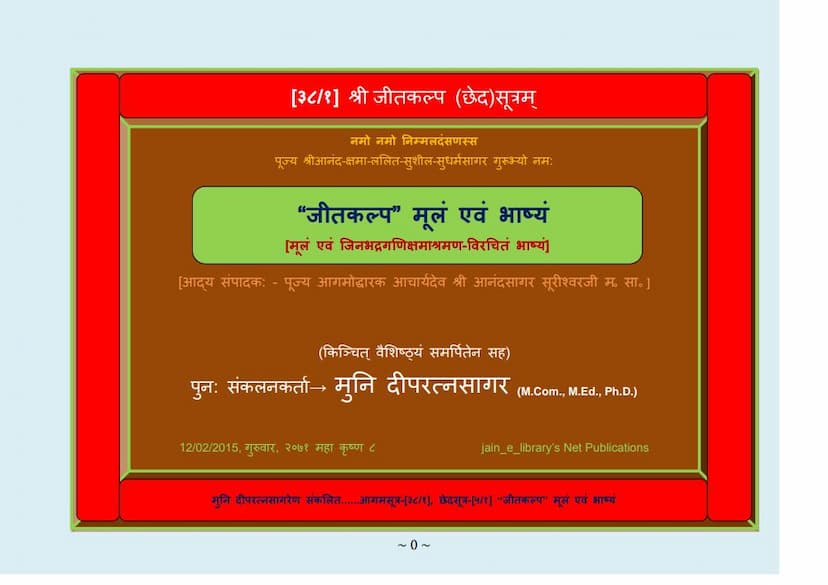Aagam 38 A JEETKALP Moolam Evam Bhashya
Added to library: September 1, 2025

Summary
Here's a comprehensive summary of the Jain text "Aagam 38 A JEETKALP Moolam evam Bhashya" based on the provided pages:
Title: Aagam 38 A JEETKALP Moolam evam Bhashya (Agam 38: Jeetkalp - Original Text and Commentary)
Author(s):
- Original Text: Jinabhadragani Kshamaashramana
- Commentary (Bhashya): Jinabhadragani Kshamaashramana
- Compiler/Re-compiler: Muni Dippratnasagar (M.Com., M.Ed., Ph.D.)
- Editor/Reviser: Acharya Shri Anand sagar Surishwarji Maharaj (also referred to as Sagarānandasūrījī)
Publisher: Deepratnasagar
Publication Details:
- Date of compilation mentioned: Thursday, February 12, 2015 (2071 Mah Krishna 8)
- The publication is presented as a "Net Publication" by jain_e_library.org, with plans for future printing.
- The text is a "Chhed-Sutra" (disciplinary scripture) and is referred to as Agam [38/1] and Chhed-Sutra [5/1].
- The original text and commentary were inscribed on stone tablets at Shatrunjay Tirth and on copper plates in Surat.
- This publication is a photo-scanned reproduction of the 6+1 Chhed-Sutras that were part of a larger work called "Agam Manjusha," compiled and edited by Acharya Shri Anand sagar Surishwarji in 1942 (Vikram Samvat 1998).
Core Content and Purpose:
The "Jeetkalp" is a significant Chhed-Sutra within the Jain Agamas, focusing primarily on disciplinary rules, penances (prayaschitta), and the conduct of ascetics (munis), particularly monks. The title itself, "Jeetkalp," implies rules for overcoming or conquering (jeet) certain situations or transgressions, likely related to ascetic life.
Key Themes and Topics Covered (as indicated by the table of contents and page content):
The text elaborately details various types of penances and expiations required for different transgressions or lapses in conduct for ascetics. These include:
- Mangalam (Benediction): The text begins with auspicious invocations.
- Tapa Prayaschitta (Penance through Austerity): This section likely deals with expiations involving various forms of austerities.
- Mala Prayaschitta (Penance for Impurities/Defilements): This addresses expiations for mental, verbal, or physical impurities.
- Alochana Prayaschitta (Confession/Repentance Penance): This is a crucial aspect, detailing the process of confessing transgressions to an elder (Acharya) as a means of purification. The text emphasizes the importance of sincere confession and the conditions under which it is performed.
- Pratikramana Prayaschitta (Reversal/Expiation Penance): This involves the act of mentally or verbally reversing or nullifying a transgression.
- Kayotsarga Prayaschitta (Penance through Self-Inactivity/Meditation): This likely refers to penances performed by remaining still and meditating.
- Visesh Prayaschitta (Special Penances): This category would encompass specific and perhaps more severe penances.
- Chhed Prayaschitta (Expulsion/Exclusion Penance): These are serious expiations, potentially involving temporary or permanent exclusion from the monastic community for grave offenses.
- Pratisewana Prayaschitta (Penance for Repeated Transgressions): This likely deals with expiations for recurring mistakes.
- Parajita Prayaschitta (Defeated/Overcome Penance): This could refer to penances for severe transgressions that lead to a fall from grace or defeat.
- Upasarga Prayaschitta (Penance for Obstacles/Afflictions): Expiations related to overcoming hardships or external challenges.
- Vastu Prayaschitta (Penance related to Objects/Substances): This might cover rules about handling, using, or purifying certain objects.
- Vak Prayaschitta (Penance for Speech): Expiations related to inappropriate or transgressing speech.
- Chitta Prayaschitta (Penance for Mind): Expiations related to mental transgressions like anger, ego, deceit, and greed.
- Ling Prayaschitta (Penance related to the Monastic Symbol/Identity): This could involve rules related to maintaining the purity of the monastic identity.
- Kaya Prayaschitta (Penance for Body): Expiations for physical transgressions.
- Acharya & Upadhyaya Prayaschitta: Specific penances related to the conduct and responsibilities of Acharyas (preceptors) and Upadhyayas (teachers).
- General principles of conduct: The text also elaborates on the nuances of monastic life, including the importance of knowledge (jnana), right conduct (charitra), proper behavior, and the detailed classification of various states and actions. It delves into the intricacies of ascetic practices, the importance of the five samitis (carefulness) and three guptis (restraints), and the various types of knowledge (Paryaya, Avadhi, Manahparyaya, Kevala Jnana).
Methodology and Presentation:
- Commentary (Bhashya): The text is presented with an original commentary (Bhashya) attributed to Jinabhadragani Kshamaashramana, providing detailed explanations and interpretations of the sutras.
- Structure: The publication follows a specific format, with the original compiled pages placed in the center. The top header indicates the name of the Agama, study/section, and the sutra/verse number. The left side shows the Agam order and the current text's sutra sequence, along with a "Deep Anukram" (Deep's sequence/index) for cross-referencing with other publications.
- Clarity: Footnotes are provided at the bottom of many pages, offering specific insights into the subject matter, potential printing errors, or numbering discrepancies in the original manuscripts.
- Accessibility: The compiler, Muni Dippratnasagar, expresses his motivation to make these crucial Chhed-Sutras accessible to a wider audience, particularly through digital platforms like jain_e_library.org, recognizing the reverence people hold for Acharya Shri Sagarānandasūrījī's work.
Significance of the Compilation:
The compilation by Muni Dippratnasagar is a significant effort to preserve and disseminate the teachings of the Jeetkalp Chhed-Sutra. By photo-scanning and digitizing the work, it ensures that this vital aspect of Jain monastic discipline is available to scholars and practitioners worldwide, preventing the perception that the Jain canon only consists of the 39 main Agamas and that these 6+1 Chhed-Sutras are missing. The meticulous formatting and cross-referencing are intended to aid serious study and understanding.
In essence, "Aagam 38 A JEETKALP Moolam evam Bhashya" is a foundational text for understanding the rigorous disciplinary framework and the detailed penance system within Jain monasticism, explained through an ancient authoritative commentary and made accessible through modern scholarship and technology.